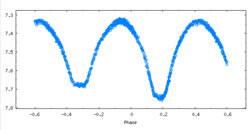| Observation data Epoch J2000 Equinox J2000 | |
|---|---|
| Constellation | Centaurus |
| Right ascension | 14h 16m 57.22s [1] |
| Declination | −57° 51′ 15.6″ [1] |
| Apparent magnitude (V) | 7.29 [2] (7.27 - 7.68 [3] ) |
| Characteristics | |
| Spectral type | F0 V [4] |
| U−B color index | +0.05 [2] |
| B−V color index | +0.36 [2] |
| Variable type | W Uma [3] |
| Astrometry | |
| Radial velocity (Rv) | -16.0 [5] km/s |
| Proper motion (μ) | RA: -52.00 [6] mas/yr Dec.: -22.63 [6] mas/yr |
| Parallax (π) | 10.16±0.61 mas [6] |
| Distance | 320 ± 20 ly (98 ± 6 pc) |
| Absolute magnitude (MV) | +1.882 [4] |
| Orbit [7] | |
| Primary | RR Cen A |
| Companion | RR Cen B |
| Period (P) | 0.60569 days |
| Semi-major axis (a) | 3.92 ± 0.19 R☉ |
| Eccentricity (e) | 0 |
| Inclination (i) | 81.00 ± 0.44° |
| Details [7] | |
| RR Cen A | |
| Mass | 1.82 ± 0.26 M☉ |
| Radius | 2.1 ± 0.01 R☉ |
| Luminosity | 8.89 L☉ |
| Temperature | 6,912 K |
| RR Cen B | |
| Mass | 0.38 ± 0.06 M☉ |
| Radius | 1.05 ± 0.03 R☉ |
| Luminosity | 2.2 L☉ |
| Temperature | 6,891 ± 13 K |
| Other designations | |
| RR Cen, 2MASS J14165721-5751156, HD 124689, HIP 69779, SAO 241587, TYC 8686-210-1, Cordoba Durchmusterung CD-57 5498 [1] | |
| Database references | |
| SIMBAD | data |
RR Centauri is a variable star with an apparent magnitude of +7.29 when it is at its brightest. It is located in the constellation of Centaurus, approximately 320 light years distant from the Solar System. [6]
The system is a contact binary of the W UMa type - two stars in physical contact whose two components share a gaseous envelope — with a variation in brightness of 0.41 magnitude. [7] Its spectral type is A9V or F0V. [1] The binary nature of the star was discovered in 1896 by the Scottish-South African astronomer Alexander Roberts, so the system has been well observed for over a century. [8] The primary component has a mass of 1.82 solar masses, an effective temperature of around 6900 K, and a radius somewhat larger than twice the solar radius. [7] The secondary component is 0.39 solar masses, giving a mass ratio of the system (q) of 0.210. the secondary has a temperature of about 6890 K and a radius is almost equal to the solar radius.
The orbital period of this system is 0.6057 days (14.54 h). Calculations by astronomers from the Chinese Academy of Sciences show a possible cyclic variation in orbital period over 65.1±0.4 years whose amplitude is 0.0124±0.0007 d. [7] The origin of this periodic variation could be due to the gravitational influence of a third object yet observed. Superimposed on this variation seems to be a secular increase in the period of 1.21×10−7 d/a, suggesting that there is transfer of stellar mass from secondary to primary component. If this increase is confirmed, RR Centauri may evolve into a single rapidly rotating star.[ citation needed ]
